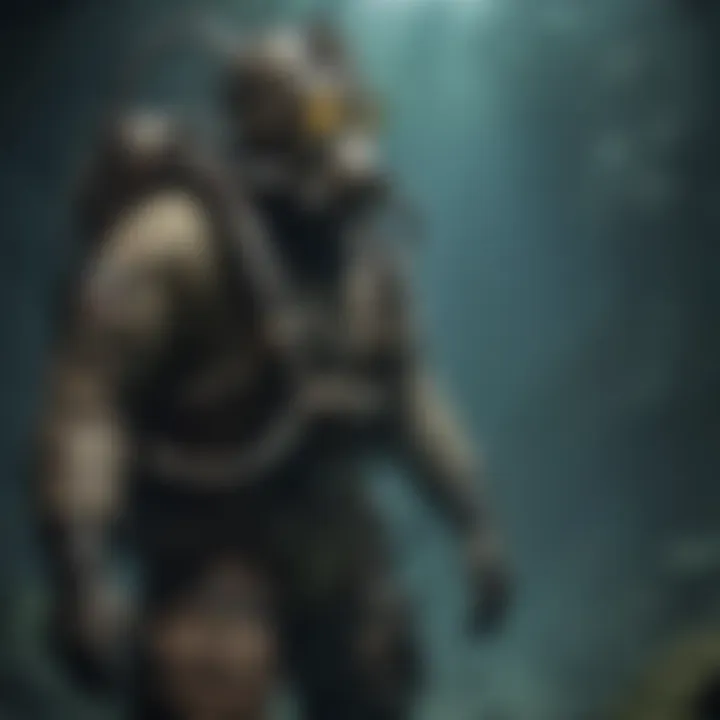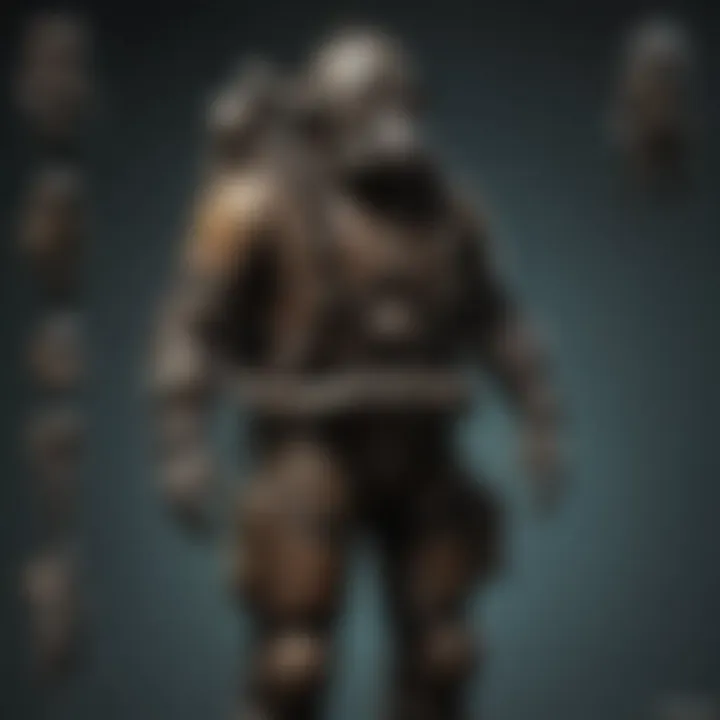Underwater Rebreathers: A Comprehensive Analysis


Intro
Underwater rebreathers are advanced diving tools that allow divers to effectively recycle their breath while submerged. This technology brings a significant evolution from traditional breathing apparatus by providing greater efficiency and extended dive times. As discussions surrounding rebreathers grow, understanding their design and function becomes crucial for both novices and seasoned divers alike. An exploration into this subject reveals the complexities of rebreather systems and their multipronged applications across various underwater endeavors.
In the following sections, we will dissect the advantages and disadvantages of underwater rebreathers, addressing critical safety considerations, specific applications in the field, and future advancements in the technology. This not only aids in comprehending their viability but also informs choices for diving professionals and enthusiasts as they consider integrating this equipment into their underwater explorations.
Design and Functionality
Over the years, underwater rebreathers have been meticulously engineered to optimize underwater experiences.
How Rebreathers Work
Rebreathers operate by filtering exhaled carbon dioxide and sometimes replenishing oxygen. This is achieved through a series of components that include:
- Counter Lung: This is where exhaled gas collects and is cycled back.
- CO2 Scrubber: This element removes carbon dioxide from the exhaled breath.
- Oxygen Supply System: This provides supplementary oxygen, maintaining the desired balance in the diver’s breathing mix.
- Mounting and Housing: The rebreather is contained in specially designed housings to protect all internal mechanics.
When activated, divers can remain underwater much longer, as the gas used is cycled rather than vented into the surrounding water. This has profound implications in sectors such as scientific research, military operations, and recreational activities.
Comparisons to Traditional Diving
Compared to traditional scuba tanks, rebreathers significantly reduce the volume of gas consumed, thus lowering environmental noise and minimizing bubble emissions. There are specific futerrals for skills when switching from tanks to rebreathers, so diver training is paramount to ensure safe usage.
Applications
The applications of rebreathers extend well into various fields:
- Technical Diving: Engaging in deeper or longer dives where traditional methods might not suffice.
- Cave Diving: Navigating challenging underwater environments where silence is essential.
- Military Use: Ideal for operational secrecy and efficiency in missions.
- Environmental Research: Collecting data from marine environments with minimal disturbance.
Understanding these applications gives a rounded perspective on the importance and versatility of rebreaddrers.
Safety Considerations
Regarding safety, it is crucial to understand all operational aspects of rebreathers. Despite their benefits, these devices come with specific risks. Key safety instructions include:
- Regular maintenance and checks on the CO2 scrubber.
- Knowledge of oxygen depth limits and monitoring.
- Proper training and knowledge to recognize hazards Jordanencie during dives.
Intro to Underwater Rebreathers
Underwater rebreathers are advanced diving systems that allow divers to breathe while submerged. Unlike traditional scuba tanks that emit exhaled gas into the water, rebreathers recycle the breath. This recycling significantly enhances dive efficiency and duration. This section explores the necessity of understanding rebreathers, looking closely at their functionality and impact, both in recreational and professional domains.
Rebreathers work by removing carbon dioxide from the diver's exhaled breath and replenishing it with oxygen. This essential principle allows for prolonged underwater time, making them invaluable for various underwater activities. The gas consumed is minimal, leading to less frequent surface immersions to refill tanks.
Key Benefits of Underwater Rebreathers:
- Extended Dive Duration: Divers can remain beneath the surface much longer.
- Reduced Bubble Production: This aspect is significant for activities like marine research, allowing divers to study wildlife closely, minimizing disturbances.
- Enhanced Freedom of Movement: Many divers find the streamlined experience of using a rebreather more favorable, further enriching their underwater experience.
However, approaching the use of rebreathers isn't without considerations. They require training and competent operation. Understanding their mechanical functions, like the scrubber system and gas mixing methods, is crucial for user safety.
"The leap from traditional diving approaches to advanced rebreathers necessitates not just technical skill, but a commitment to thorough training."
As we proceed through this article, readers will acquire a solid grounding on components specific to various rebreathers. Grasping aspects such as historical evolution, modern applications, and potential risks associated with their use provide essential insights for both seasoned divers and newcomers alike. With this foundation, further sections will delve deeper into the specifics, offering complete knowledge for enhancing underwater exploration excursions.
Historical Context
Understanding the historical context surrounding underwater rebreathers sheds light on the technological advancements and evolving applications of this fascinating equipment. Knowledge of its origins and evolution is paramount in recognizing how far the diving industry has come and why rebreathers are integral in contemporary underwater exploration. Through a retrospective view, we can appreciate the innovations that allow divers to manage air supply efficiently and enhance safety and endurance beneath the waters.


Origins of Rebreather Technology
The inception of rebreather technology can be traced back to the late 19th century. Early devices sought to provide divers with extended dive durations. The first usable designs emerged with the work of innovators like Henry Fleuss, who in the 1870s developed the first practical rebreather. This invention incorporated a closed-circuit system, enabling divers to recycle exhaled air rather than expelling it into the surrounding environment.
As the initial iterations began to surface, notable challenges arose. In particular, concerns regarding the buildup of carbon dioxide and the potential toxicity of gases limited the applications of these rebreathers. Innovations focused on scrubbing devices, which were designed to eliminate carbon dioxide effectively. The essence of these advancements laid the groundwork for future models.
Evolution Over the Decades
The evolution of underwater rebreathers has been marked by significant advancements, guided by military needs, scientific research, and recreational demands. Following the world wars, innovations boosted civilian military diving capabilities. The closed-circuit rebreather gained fame, particularly with its adoption by military personnel for stealth operations.
Technological improvements in materials science during the late 20th century led to lighter, more durable designs. Modern units leverage sophisticated oxygen management systems that enhance breathing efficiency, allowing divers to remain submerged for prolonged periods. As interest in recreational diving surged, manufacturers began to cater to this burgeoning market. Measurements of performance and safety evolved, prompting a shift toward semi-closed circuit rebreathers in recreational contexts.
These developments illustrate not just a variation in technology but also a response to the needs of divers across different contexts.
Understanding historical context gives valuable insight into the advancements of rebreather technologies that dictate current practices in diving.
In summary, rebreathers have come a long way from Fleuss's early designs. There is more sophistication and versatility molded by decades of military requirements and recreational demands. The study of their historical evolution offers a foundation to comprehend contemporary and forthcoming innovations.
- Understanding the Mechanics
Understanding the mechanics of underwater rebreathers is crucial for grasping how these devices enable extended diving experiences. This topic provides insight into the various components that make up these complex systems, as well as how they function most efficiently. Knowing the mechanics allows divers to appreciate the engineering behind their safety, comfort, and the unique experience afforded by rebreathers.
Core Components
Gas Mixing System
The gas mixing system is essential within a rebreather. This component blends oxygen and other gases, ensuring optimal mixture ratios tailored for the depth and duration of a dive. By managing gas concentrations, the system helps prevent issues like hypoxia and hyperoxia.
A key characteristic of the gas mixing system is its ability to fine-tune breething gases in real-time. This particularity makes it critical for deep dives or extended adventures. Advanced models often integrate sensors to monitor gas levels and automatically adjust the mixes as needed. However, reliance on electronic systems, while advantageous for precision, introduces challenges such as potential system failures that divers must consider when selecting rebreathers.
Scrubber
The scrubber plays an indispensable role in rebreather functionality. Its primary function is to remove carbon dioxide from exhaled gas from the diver, allowing for fresher air to cycle back into the system. The scrubber is engineered using chemical processes that neutralize CO2, thus extending the life of the breathed air.
One of the scrubber’s standout features is its dual-phase operation that effectively captures carbon dioxide during multiple breath cycles. This not only provides benefits in terms of air quality but also enhances overall buoyancy control. Limitations can arise from factors such as absorbent material saturation, impairing its efficiency and potentially posing risks to divers if not monitored closely.
Breathing Loop
The breathing loop represents the closed system where inhalation and exhalation occur. This loop circulates the air being breathed by the diver to maximize gas efficiency and minimize environmental impact. The design allows for longer durations underwater, as this closed-loop management decreases the amount of gas consumed.
A notable trait of breathing loops is the fundamental connection they provide between the diver and the surrounding aquatic environment. They offer an ergonomic fit improving comfort during use. Despite these advantages, performance can degrade with prolonged usage, leading to necessary maintenance and checks to ensure consistent functionality.
Principles of Operation
The principles governing operation highlight how various components integrate to create a seamless diving experience. A balanced understanding of these necessities ensures divers remain informed in both recreational and professional settings, promoting optimal safety and exploration.
Types of Underwater Rebreathers
Understanding the different types of underwater rebreathers is crucial in appreciating their unique functionalities, benefits, and applications. Each type has specific designs suited for various environments and operational needs. Identifying which rebreather models are appropriate for particular scenarios influences both safety and efficiency for divers.
Closed-Circuit Rebreathers
Closed-circuit rebreathers (CCR) recirculate exhaled gases, which is a defining characteristic of this type. This closed system removes carbon dioxide from exhaled air and mixes oxygen back in. The efficiency of oxygen use and lower bubbles output can be paramount in certain conditions.
CCRs are particularly favored in professional environments, such as military diving and deep technical dives. They allow a diver to stay submerged longer, utilizing a fully integrated system to recycle gases. Because they limit the release of bubbles into the water, they enhance the diver’s stealth and reduce the effects of noise on marine life.


A critical element to pay attention to with CCRs is the oxygen partial pressure. Managing this value is necessary to prevent hypoxia at depth, which means having a comprehensive understanding of the adjustments needed during diving. Maintenance and training for managing a CCR is important, as improper handling can lead to serious problems, especially when diving to great depths.
Semi-Closed Circuit Rebreathers
Semi-closed circuit rebreathers (SCR) strike a balance between simplicity and functionality. This system allows exhaled gases to escape into the water, while the necessary gases, mainly oxygen, get replenished. The design is more straightforward compared to CCRs.
SCRs are well-suited for recreational divers and those engaging in warm-water diving. These devices feature simpler mechanics and are therefore easier to operate, making them a practical choice for less experienced divers or various diving contexts.
Yet, there are trade-offs. With semi-closed systems, there is a potential for wasting oxygen due to the gases vented out. However, total gas consumption can still be lower compared to standard scuba gear. Scrubbers in these systems also require monitoring, as contaminated or exhausted scrubber materials can be hazardous. Thus, while SCRs provide freedom in deployment, diligent maintenance is equally necessary. The operational differences make it also essential to select the right type depending on diving objectives.
Applications of Underwater Rebreathers
The applications of underwater rebreathers are vast and varied, underpinning their relevance in numerous fields. As divers continue to push the boundaries of underwater exploration, understanding how these devices are used can greatly enhance both safety and efficiency. Rebreathers allow for longer dives, reduced bubbles, and less disturbance in aquatic environments, making them crucial for various sectors.
Scientific Research
In the realm of scientific research, underwater rebreathers serve as invaluable tools for researchers who study marine ecosystems. Employing these breathing devices enables scientists to conduct prolonged dives without interrupting the delicate underwater environment. The decreased noise made during rebreathing enhances the potential for observing and documenting marine life in their natural habitats. Moreover, the ability to stay submerged longer means researchers can gather more data per dive—an essential factor in ecological studies or archaeology. A suitably equipped rebreather can also allow scientists to work at various depths, paving the way for expanding our knowledge about underwater biodiversity and ecological interactions.
Commercial Diving
Commercial diving utilizes underwater rebreathers in numerous operations, ranging from underwater construction to ship maintenance. Professionals in this field rely on these systems for extended working periods underwater without the complications that come with traditional diving tanks. Their design allows divers to work deeper and longer as they blend standard air replenished with specific gas mixtures, like helium. By minimizing loss of gas to the environment, companies can conduct projects more economically and efficiently. However, commercial divers must follow stringent guidelines to minimize accidents and maximize project success. Understanding equipment and diving protocols becomes vital in achieving safety standards within this industry.
Recreational Diving
For recreational divers, underwater rebreathers offer a way to enhance immersion and experience. Divers appreciate the reduced auditory and visual disturbances as they observe marine life without the chaos of sound created by traditional diving equipment. Many advanced divers are choosing rebreathers for deeper explorations which provide them with unique experiences. Situations such as wildlife encounters or archaeological explorations become more memorable without the usual scuba tanks coming between them and the aquatic world. It’s worth noting that while these devices can escalate the diving experience, they demand additional training. Safety remains a consistent theme. Training registers from initiation to advanced levels where divers learn to maintain equipment properly and respond to emergencies effectively.
The adoption of rebreather technology significantly advances diving practices across various disciplines, fostering deeper connections to underwater environments while adhering to robust safety standards.
Safety Considerations
The safety of underwater divers using rebreather technology cannot be overstated. Understanding the inherent risks associated with this equipment and adopting proper safety measures are critical. The nature of diving itself, combined with the complexities of rebreathers, makes safety an essential concern. Knowledge of risks can prevent accidents, allowing divers to enjoy their underwater experiences without undue anxiety.
Potential Risks and Hazards
Diving with rebreathers introduces multiple potential risks and hazards that every user must recognize. Some key areas of concern include:
- Hypoxia: Insufficient oxygen can lead to unconsciousness.
- Hypercapnia: Elevated carbon dioxide levels may cause confusion or other health issues.
- Equipment Failure: Mechanical or electrical failures may lead to deadly situations.
- Decompression Sickness: Incorrect ascent rates can result in injury from nitrogen bubbles forming in the body.
- Environmental Risks: Changes in water temperature and currents add uncertainty that divers must manage.
Each hazard poses distinct challenges, and comprehensive understanding can mitigate these risks. Examples of recent incidents involving rebreathers serve as poignant reminders to respect the equipment and dive principles.
“Improper usage of rebreathers can lead to dangerous consequences, necessitating meticulous safety protocols.”
Best Practices for Safety
To ensure a safe diving experience, divers must adhere to several vital best practices when utilizing rebreathers. They include:
- Thorough Training: Acquiring proper training from qualified instructors is fundamental.
- Pre-Dive Planning: Careful planning of the dive site, objectives, and contingency scenarios is paramount.
- Regular Equipment Checks: Ensuring that all components of the rebreather function properly before each dive can prevent failures.
- Buddy System: Diving with a partner allows for mutual support in case of emergencies.
- Continuous Monitoring: Keeping an eye on gas mixes, pressure, and environment during the dive prevents upstream issues.
- Know Emergency Procedures: Familiarizing oneself with emergency protocols can potentially save a life.
- Adapt to Conditions: Assessing environmental conditions regularly can dictate changes in the dive plan.
By integrating these best practices into their routines, divers greatly enhance their security underwater. A logical approach to safety cannot be disregarded in an activity filled with inherent risks.
Comparative Analysis of Models
Comparative analysis of underwater rebreather models is essential for understanding the various available options, their unique features, benefits, and shortcomings. For divers, this analysis helps in making informed choices that can significantly influence their diving experience. Understanding differences between models can elicit valuable insights about mechanics, durability, and performance. given the complexity and specialized usage of underwater rebreathers, evaluation of models is not just academic but highly practical.
A good comparative analysis centers on multiple factors. First is the technological innovation in each rebreather, which affects performance. Second, the ergonomics involved can enhance usability when it comes to comfort underwater. Third, price factors into these decisions; understanding which model delivers optimum value over cost is crucial.


Ultimately, evaluating different models leads to informed decisions that emphasize safety, efficiency, and usability. In situations involving diving, this analysis enhances overall diving experiences and operational safety across various underwater environments.
Popular Brands and Models
When discussing popular brands of underwater rebreathers, particular names stand out due to their reputation for quality and performance. Noteworthy brands include Aqua Lung, Hollis, and rEvo. Each brand offers distinct characteristics that cater to various diving needs.
- Aqua Lung: Known for versatility and user-friendliness, their R1 model is particularly favored for recreational diving.
- Hollis: Their Prism 2 model is claimed to provide advanced features suitable for professionals, along with a compact design.
- rEvo: rEvo focusing on closed-circuit systems has produced durable variants that diving experts often recommend.
Each of these brands has established a following, securing a position through relentless dedication to quality and evolving technology.
Performance Metrics
Performance metrics directly indicate how efficiently rebreather models function underwater. Several evaluative dimensions can illuminate product capabilities. Key metrics include:`
- Depth Rating: This tells divers how deep they can safely operate, typically extending to depths of 30 meters or more.
- Duration: The operational time before servicing; this affects usability during longer dives. Lasting endurance allows extended exploration of underwater environments.
- Gas Efficiency: Effective mixing of gases is critical. Efficiency can mean longer dive times and enhanced safety.
- Weight: Lightweight designs facilitate easier movement. This consideration can affect overall user experience while submerged.
Diving enthusiasts and professionals alike rely on these performance metrics. Choosing models that meet specific performance standards is important, ensuring optimal safety and diving enjoyment.
Successful diving with rebreathers requires understanding intricacies from models to performance insights. Thus, engaging in comparative analysis remains pivotal.
Future Trends in Underwater Rebreather Technology
Future trends in underwater rebreather technology are essential for understanding both current capabilities and future possibilities. This section delves into advancements that promise to enhance safety and efficiency for divers, improve usability of devices, and encourage wider adoption of rebreather technology across various sectors. The exploration of technological innovations can uncover the path through which equipment is expected to evolve, while environmental considerations emphasize the need for sustainable practices in future designs.
Technological Innovations
New technologies are making underwater rebreathers smarter and more effective. One significant area of development is miniaturization. Equipment designers aim to make these systems more compact and lightweight, which offers better mobility for divers. Compact designs can improve comfort and reduce fatigue during prolonged use.
Advancements in sensor technologies are also notable. Integrating sensors allows rebreathers to monitor several parameters in real-time. This capability can enhance safety and performance, providing divers with essential feedback on their breathing gas composition, depth, or even the presence of pollutants.
Moreover, there's great interest in software advancements. Systems can be paired with smartphone applications to offer divers timely data right at their fingertips. Real-time analytical processing is crucial for making immediate decisions during underwater operations. This effectively can lead to safer dive experiences.
Lastly, modular designs are gaining attention. This allows divers to customize their rebreather setups based on specific diving needs. Streamlining this customization process ensures users can fit their systems to various operational environments, from wreck dives to scientific missions.
Environmental Considerations
As diving technology evolves, so, too, does the imperative to consider its impact on the environment. Development of eco-friendly scrubbing materials and gas substitutes can significantly lessen emissions traditionally associated with diving activities. Innovations in materials science form the backbone of creating sustainable parts that do not inhibit performance.
Additionally, the energy efficiency of rebreather systems is being examined. Recognizing that energy consumption during diving operations can be considerable, designers focus on creating efficient thermal management systems to extend durability while reducing overall system weight.
Another focal point in environmental advancements is the commitment to recycle and repurpose materials used in manufacturing. The industry's move toward circular economy frameworks entails designing products so they can be reused or recycled when their life cycle ends. This not only minimizes waste but also conserves resources. Industries utilizing underwater rebreathers can support sustainability by choosing devices certified as environmentally friendly.
In advancing underwater rebreathers, the confluence of technology and environmental stewardship is not merely beneficial; it is requisite for the sustainability of underwater exploration.
Overall, monitoring and optimizing environmental impacts while creating next-generation diving technologies serve a dual purpose—ensuring safety and operating within ecological bounds. Future rebreathers must strike a balance between minimizing negative effects and maximizing operational effectiveness to provide divers with tools to explore more while protecting the marine ecosystem they traverse.
Closure
In this article, the exploration of underwater rebreathers brings to conclusion a multifaceted discussion on a critical aspect of diving technology. This technology is significant for divers, researchers, and commercial operators, fostering deeper exploration of aquatic environments.
Understanding the importance of rebreathers lies in their ability to extend dive times while reducing nitrogen narcosis and other risks inherent in traditional diving. Their design incorporates a complex understanding of gas calculations and scrubbing processes, which ensures that divers inhale oxygen while expelling carbon dioxide. This makes it a more efficient way to utilize gases under pressure.
The benefits of rebreathers are clear. They allow divers to conduct longer dives, explore intricate wreck sites, or carry out significant conservation work without the need for frequent surface ascents. Additionally, minimizing bubbles provides environmental advantages, helping to protect sensitive marine life.
However, it is equally important to consider potential hazards. Improper use of underwater rebreathers can lead to serious health risks, such as hypoxia or hypercapnia, underlining the requirement for rigorous training and adherence to safety protocols. Safety is non-negotiable. Every diver using this technology must gain understanding of protocols and maintenance practices.
Future advancements could see improvements in the design and functionality of rebreathers. Enhanced materials, improved scrubbers, and more user-friendly interfaces are areas of active research. This focus signifies a movement towards making rebreathers more accessible, supporting both recreational and scientific applications without compromising safety.
In concluding this exploration, we highlight the essentiality of knowledge within this field. Understanding the mechanics, applications, and future potential of underwater rebreathers not only aids attentive divers but also contributes to enhancing discussions regarding the future of diving technology.
"The journey through the depths is as much about technology as it is about exploration and safety.”







